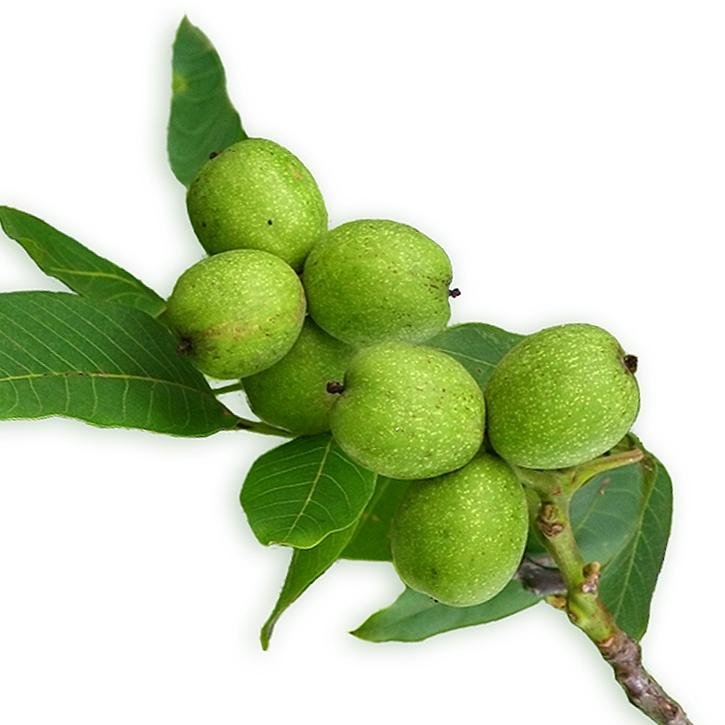It is original from Persia was introduced in Rome through Greece then to all western Europe; finally it arrived to North and South America. It is cultivated in most of the Mediterranean and Atlantic region. It blooms in May-June. Fruits ripe at the end of summer and are harvested in autumn. The fleshy layer is peeled off and the walnut let to dry.
Mainly the leaves and in rare occasions, the fruits (walnuts) and the fruit pericarps.
*Leaves
*Fruit pericarp
*Oil
- Real Farmacopea Española, Suplemento 1999.
- Real Farmacopea Española, Suplemento 2001.
- Pharmacopée Française IX Édition.
- Plantas Medicinales. Thérapeutique-Toxicité. Christiane Vigneau. Masson, Paris 1985.
- Herbal Drugs and Phytopharmaceuticals. Norman Grainger Bisset (Ed). Max Wichtl. CRC Press.1994.
- Plantas Medicinales y Drogas Vegetales para infusión y tisana. Edición española a cargo de: Salvador Cañogueral, Roser Vila, Max Wichtl.1998.
- Matière Médicale. RR Paris- H. Moyse. Masson 1981.
- The Complete German Commission E Monographs. Therapeutic Guide To Herbal Medicines. Mark Blumenthal. American Botanical Council 1998.
- Fitoterapia Aplicada. J.B. Peris, G. Stübing, B.Vanaclocha. Colegio Oficial de Farmacéuticos de Valencia 1995.
- Fitoterapia: Vademecum de Prescripción. Plantas Medicinales. Colaboran: Asociación española de médicos naturistas. Colegio Oficial de Farmacéuticos de Vizcaya.
- Plantas Medicinales. El Dioscórides Renovado. Pio Font Quer.
- Guía de Campo de las Flores de Europa. Oleg Polunin. Ediciones Omega S.A. Barcelona, 1977.
- Pharmacognosy 9th edition. Varro E. Tyler – Lynn R. Brady – James E. Robbers.
- Farmacognosia. G.E. Trease y W. C.Evans. CECSA.
- Plantas Medicinales. Margarita Fernandez y Ana Nieto. Ed Universidad de Navarra. EUNSA 1982.
- 100 Plantes Medicinales. Max Rombi. Romart 1998.
- Pharmacognosy, Phytochemistry, Medicinal Plants. Jean Bruneton. Lavoisier Publishing.
- Enciclopedia de las Hierbas Medicinales. Tina Cecchini. Ed. de Vecchi S.A. 1995.
- Pharmacognosy, Phytochemistry, Medicinal Plants. Jean Bruneton. Lavoisier Publishing.
- The Complete German Commission E Monographs. Therapeutic Guide To Herbal Medicines. Mark Blumenthal. American Botanical Council 1998.
- Blumenthal M, Goldberg A, Brinckmann J. Herbal Medicine, Expanded Commission E Monographs. Integrative Medicine Communications, Newton. First Edition, 2000; pp 401-3.
- Bézanger-Beauquesne, L; Pinkas, M; Torck, M. Les Plantes dans la Therapeutique Moderne. 2ª. Paris: Maloine, 1986, pp. 260-1.
- Bézanger-Beauquesne, L; Pinkas, M; Torck, M; Trotin, F. Plantes Médicinales des Regions Tempérées. Paris: Maloine, 1980, pp.68-9.
- Wichtl, M. Herbal Drugs and Phytopharmaceutical. A Handbook for Practice on a Scientific basis. Stuttgart: Medpharm Scientific Publishers, 1994, pp. 281-2.
